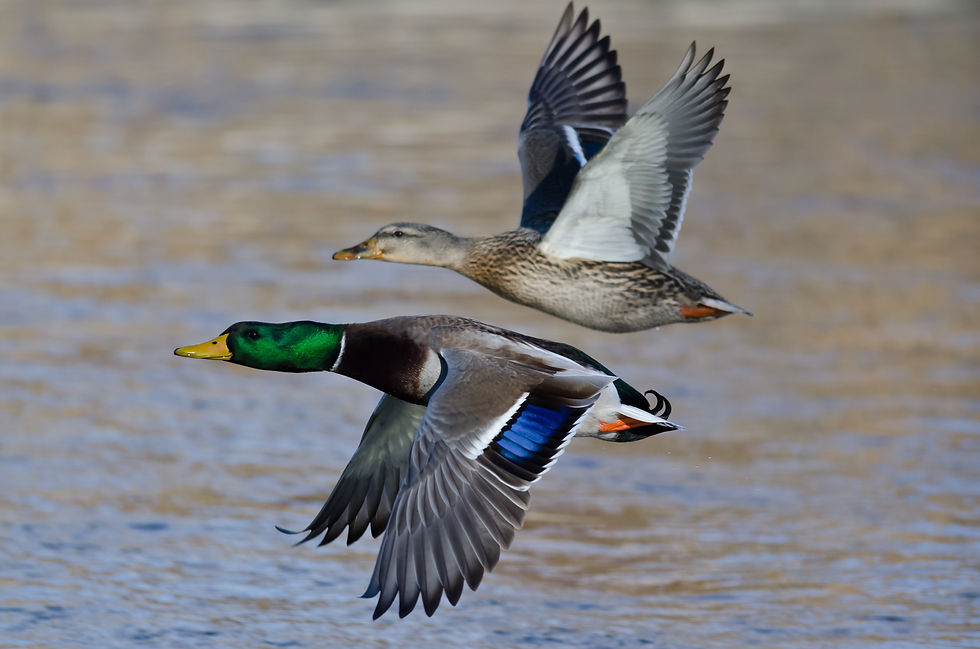The Threat of Mallard Hybridization in the Great Lakes: Echoes of the Atlantic Flyway
- Eric Lance CWB®, CNRP
- Apr 3, 2024
- 3 min read

In recent years, the Great Lakes region has witnessed a concerning trend that echoes the ecological dynamics observed in the Atlantic Flyway: the rise of hybridization between wild mallards (Anas platyrhynchos) and feral game farm mallards. This phenomenon poses significant threats to the genetic integrity and sustainability of wild mallard populations, with potential repercussions for the biodiversity and ecological balance of wetland habitats. This blog article delves into the scientific details of this issue, incorporating recent research findings to underscore the urgency and complexity of the challenges faced.
Understanding the Hybridization Phenomenon

Hybridization in waterfowl, particularly between wild and feral mallards, is not a new concern. However, its increasing prevalence in the Great Lakes region has raised alarms among conservationists and researchers alike. Feral game farm mallards, often released for hunting purposes, lack the wariness and migratory instincts of their wild counterparts. Their integration into wild populations through breeding leads to hybrid offspring that may inherit undesirable traits, compromising survival skills and adaptability.
Recent genetic studies have illuminated the extent of this problem. A comprehensive analysis by Lavretsky et al. (2021) in the journal Conservation Genetics highlights the genetic admixture between wild and feral mallards across various parts of North America, including the Great Lakes. The study points to a significant genetic dilution in these areas, mirroring patterns observed in the Atlantic Flyway, where the genetic distinction between wild and feral mallards has been increasingly blurred.
Implications for the Mississippi Flyway and Biodiversity

The Mississippi Flyway, a critical migratory corridor for millions of waterfowl, including mallards, is witnessing a gradual but noticeable shift in the genetic makeup of its mallard population. This shift not only affects the mallards themselves but also has cascading effects on the ecosystem. Hybrid mallards with diminished migratory behaviors can alter local waterfowl distribution patterns, compete with native species for resources, and potentially introduce diseases.
Moreover, the presence of hybrid mallards complicates conservation and management efforts. Traditional strategies that rely on the natural migratory patterns and habitat preferences of wild mallards may not be as effective for managing a population with a significant proportion of hybrids. As noted by Fleskes et al. (2018) in Wildlife Society Bulletin, understanding and managing the impacts of hybridization on waterfowl migration and habitat use are becoming increasingly complex, necessitating novel approaches and adaptive management strategies.
Recent Scientific Research and Conservation Responses
Recognizing the threat posed by mallard hybridization, recent scientific research has focused on developing methods to monitor and manage this issue more effectively. For instance, Johnson et al. (2019) in Journal of Wildlife Management explored the use of genetic markers to distinguish between wild, feral, and hybrid mallards. Such tools are invaluable for conservationists seeking to assess the extent of hybridization within specific populations and implement targeted management interventions.
Conservation responses have also evolved to address the challenge of hybridization. Strategies include regulating the release of game farm mallards, enhancing public awareness about the ecological risks of releasing domesticated mallards into the wild, and promoting habitat restoration efforts that support the needs of wild mallard populations. These efforts aim to preserve the genetic integrity of wild mallards and ensure the resilience of wetland ecosystems in the face of changing environmental conditions.
Conclusion
The rise of mallard hybridization in the Great Lakes region is a complex challenge that mirrors the ecological dynamics previously observed in the Atlantic Flyway. This issue underscores the interconnectedness of ecosystems and the far-reaching impacts of human activities on wildlife. Through a combination of rigorous scientific research and adaptive conservation strategies, there is hope for mitigating the threats posed by hybridization and preserving the genetic diversity and ecological balance of North America's waterfowl populations. The efforts to combat this phenomenon in the Great Lakes and beyond will require sustained collaboration among researchers, conservationists, policymakers, and the public to ensure the long-term sustainability of these iconic birds.
References:
Lavretsky, P., et al. (2021). "Assessing the genetic impact of feral game farm mallards on wild mallard populations." Conservation Genetics.
Fleskes, J.P., et al. (2018). "Impacts of hybridization on migratory behaviors of waterfowl: A review." Wildlife Society Bulletin.
Johnson, W.P., et al. (2019). "Genetic markers for distinguishing wild and feral mallards and their use in wildlife management." Journal of Wildlife Management.

Comentários